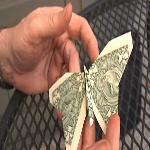
The ancient Japanese art of origami - or paper folding - is thriving today in San Francisco - thanks largely to an American scientist.
Remember how much fun it was to play with paper airplanes as a kid? Most people give up those kinds of hobbies once they grow up, but not Robert Lang.
"The biggest thing was just like this paper airplane, it was a way that you can make something with found materials, cheap paper, scraps, even trash," said Lang.
Lang lives in the San Francisco bay area. He is a laser physicist and graduate of the California Institute of Technology, and has nearly 50 U.S. patents to his name. Eight years ago he gave up his job to pursue origami, making him one of the few professional origami artists in the country. He never stops creating, even during lunchtime.
"I'll give it to the waitress. It'll be part of the tip," he added.
But Lang can turn bills into lots of other things besides butterflies.
"This was folded from two individual dollar bills," he added. "I paid two dollars for the two dollar bills."
This flower was made from six one-dollar bills. This plate was made with three, and another three for the lobster. Under his expert hands, paper of almost any type, stiffness or thickness can be turned into a work of art.
"Different papers suggest different subjects. And in some cases, the paper itself suggested what the best subject was. When I saw this paper, the Mexican paper, I immediately thought I want to fold it into a pot," he said.
Using his understanding of complex geometric forms, Lang has played an important role in origami's evolution. Many of these models were unheard of just 10 or so years ago.
"The reason I do a lot of animals is because I'm inspired by the real thing," he explained.
Lang's works have been displayed in the Lindsay Wildlife Museum near San Francisco for years. Loren Behr is executive director of the museum.
"It is kind of hard to believe sometimes when I look at his work to realize that one sheet of paper goes into each of the animals with all of the complexities. All the amazing number of folds ... I can't imagine that he can actually do that."
Many countries around the world have origami traditions. But it has played a particularly important role in Japanese culture. The English term origami is a transliteration of the Japanese word. "Ori" means "paper," and "gami" means "to fold." San Francisco's Japantown is home to some origami masters, including Linda Tomoko Mihara.
Linda is a third-generation Japanese-American. She is famous for her origami cranes, which once played an important role in Japanese culture.
"It was tradition for the bride to fold 1,000 cranes to wish for a long and prosperous marriage, and also to demonstrate her patience," she explained. Linda's grandparents compiled the first origami handbook ever published in the United States. She began doing origami at the age of five.
She and Lang have worked together. They once created all the origami models for a 3D animated commercial.
"Everything you saw in that commercial except the car was origami. So we did buildings, city buildings, Victorian houses, even the decorations in the streets around the houses. Trash cans, potted plants, street lamps," explained Robert Lang.
The great response that the commercial got has further spurred the two artist's passion to create. They are now hoping to one day do the first-ever origami movie.
origami: the Japanese art of folding paper into attractive shapes 日本折紙藝術(shù)
From clay to art: exploring the world of ceramics
Exploring the history and art of printmaking
日本擴(kuò)大文化出口 動(dòng)漫、時(shí)尚唱主角
(來(lái)源:VOA 編輯:陳丹妮)
